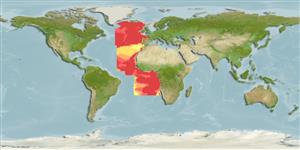Teleostei (teleosts) >
Alepocephaliformes (Slickheads and tubeshoulders.) >
Platytroctidae (Tubeshoulders)
Eponymy: Professor Dr Werner Schnakenbeck (1887–1971) was a German zoologist and ichthyologist. [...] (Ref. 128868), visit book page.
Environment: milieu / climate zone / depth range / distribution range
Ecology
Marine; bathypelagic; depth range 365 - 1200 m (Ref. 4461). Deep-water; 65°N - 24°S, 44°W - 15°E
Eastern Atlantic: eastern Greenland and western part of the British Isles to Portugal including Azores Island; off Canary Islands and Cape Verde, Gulf of Guinea, Angola and Namibia (18°45'S, 23°15'S) (Ref. 4461).
Size / Weight / Age
Maturity: Lm ? range ? - ? cm
Max length : 27.0 cm SL male/unsexed; (Ref. 4461)
Mesopelagic to bathypelagic in southern part of its range and benthopelagic from 365 to 1,200 m in the northern part (Ref. 4461).
Life cycle and mating behavior
Maturity | Reproduction | Spawning | Eggs | Fecundity | Larvae
Quéro, J.-C., T. Matsui, R.H. Rosenblatt and Y.I. Sazonov, 1984. Searsiidae. p. 256-267. In P.J.P. Whitehead, M.-L. Bauchot, J.-C. Hureau, J. Nielsen and E. Tortonese (eds.) Fishes of the north-eastern Atlantic and the Mediterranean. UNESCO, Paris. Vol. 1. (Ref. 6682)
IUCN Red List Status (Ref. 130435: Version 2024-1)
Threat to humans
Harmless
Human uses
Tools
Special reports
Download XML
Internet sources
Estimates based on models
Preferred temperature (Ref.
123201): 2.2 - 7.3, mean 5.8 °C (based on 37 cells).
Phylogenetic diversity index (Ref.
82804): PD
50 = 0.6250 [Uniqueness, from 0.5 = low to 2.0 = high].
Bayesian length-weight: a=0.00407 (0.00154 - 0.01080), b=3.17 (2.94 - 3.40), in cm total length, based on LWR estimates for this (Sub)family-body shape (Ref.
93245).
Trophic level (Ref.
69278): 3.4 ±0.5 se; based on size and trophs of closest relatives
Resilience (Ref.
120179): Medium, minimum population doubling time 1.4 - 4.4 years (Assuming tmax>3).
Fishing Vulnerability (Ref.
59153): Low vulnerability (23 of 100).
Nutrients (Ref.
124155): Calcium = 28.7 [7.0, 121.1] mg/100g; Iron = 0.47 [0.14, 1.52] mg/100g; Protein = 3.09 [0.00, 7.09] %; Omega3 = 0.174 [0.054, 0.566] g/100g; Selenium = 13.2 [3.0, 55.0] μg/100g; VitaminA = 16.8 [2.0, 126.9] μg/100g; Zinc = 0.594 [0.271, 1.488] mg/100g (wet weight);
